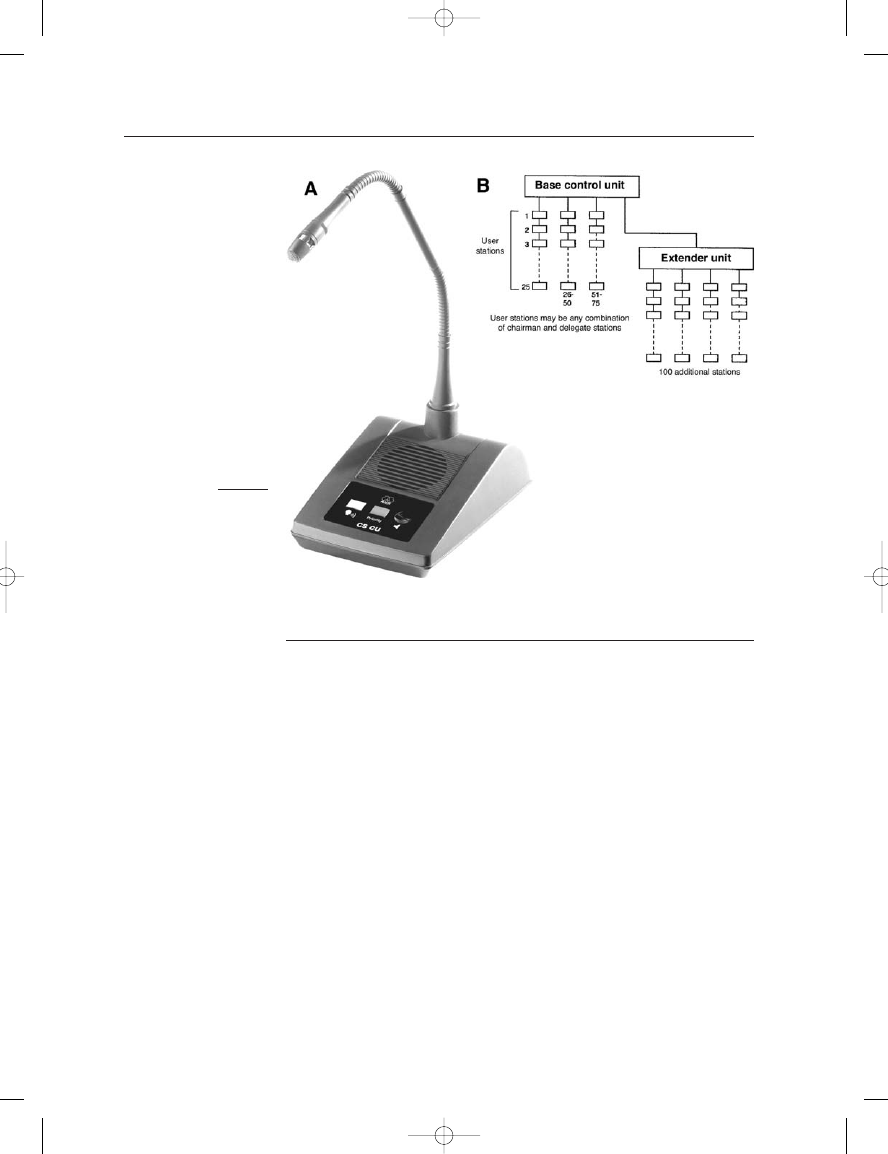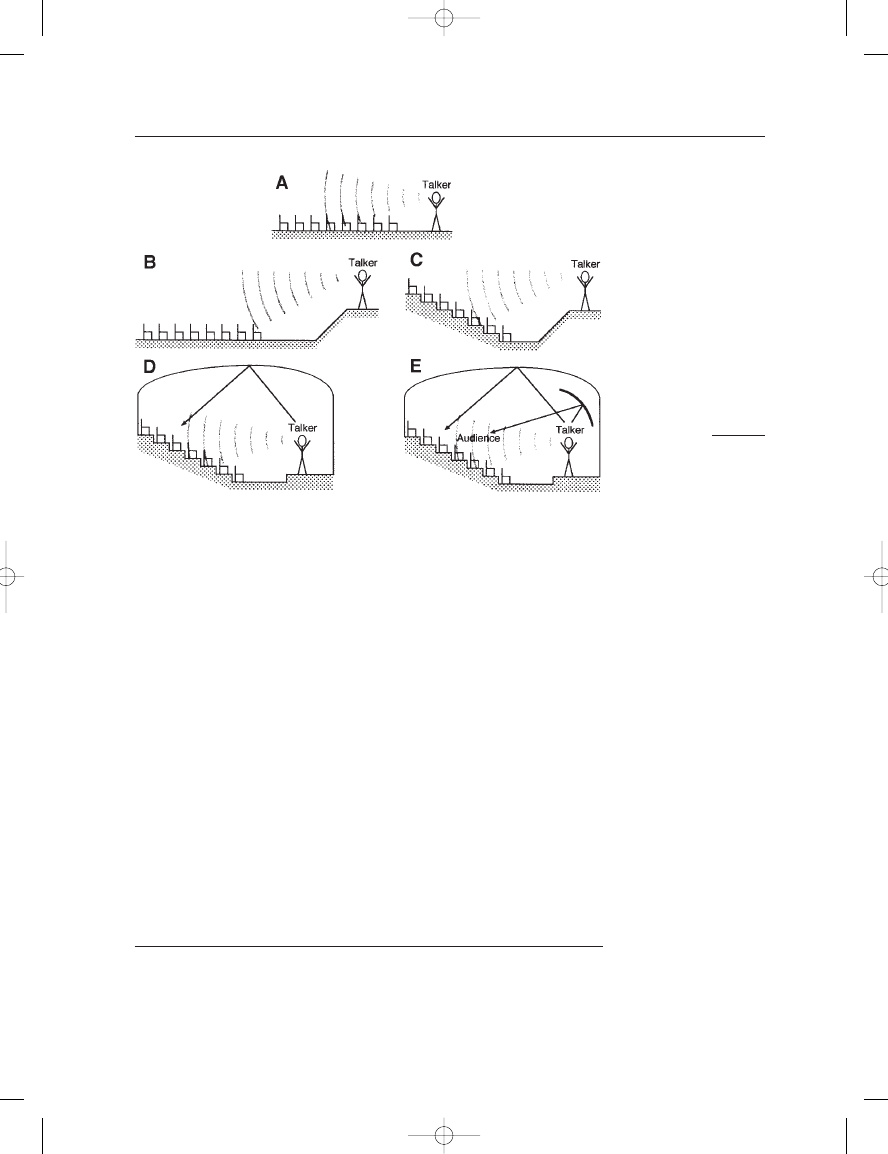ВУЗ: Казахская Национальная Академия Искусств им. Т. Жургенова
Категория: Книга
Дисциплина: Не указана
Добавлен: 03.02.2019
Просмотров: 17261
Скачиваний: 51

THE MICROPHONE BOOK
298
glazing should be used in the windows of the booth that look into the
control room and studio. The table in the center of the room should have
a well-damped surface, such as felt, to minimize scuffing noises, shuffling
of papers, and the like. We recommend that an acoustical consultant be
engaged for advice regarding construction, room treatment, and the type
of air ductwork necessary to minimize noise.
Details of microphone placement are shown at B. The engineer
should be aware that modern broadcast practice relies a great deal on
voice processing. Careful limiting, compression, and downward expan-
sion are often used to maintain consistent levels and minimize noise.
Additionally, some degree of equalization may be applied to the voice.
Some announcers with “big, radio-type voices” may exhibit pronounced
vocal waveform asymmetry, which may cause a high signal crest factor
(see Chapter 2). The effect of this may be to restrict the maximum modu-
lation level available for that announcer. Modern voice processors have
circuitry that can be engaged to minimize high signal crest factors with-
out audibly changing the timbre of the voice, thus providing for better
overall on-air transmission.
CONFERENCE SYSTEMS
Large conferences more often than not are presented in midsize meeting
rooms using a classroom setup. The basic requirement grows out of the
fact that all attendees are participants and may be called upon to address
the group as a whole. Often, several levels of priority are required. A
chairperson, of course, is in charge of the meeting’s proceedings.
Additionally, sub-chairpersons may be responsible for smaller delega-
tions. Here is a general description of such a system:
Chairpersons use a special station that allows them priority of all
delegate stations of lower priority. Under normal conditions, when talk-
ing, the chairperson’s voice is heard at all stations. When comments from
the delegates are desired, the delegate engages his or her station; and this
mutes the local station’s loudspeaker so that feedback does not take
place. Comments are then heard over the rest of the stations. The maxi-
mum number of units that can be engaged at a given time can be set by
the chairperson, and the overall system gain is automatically adjusted
downward in order to inhibit feedback. All the microphones are cardioid
in pattern and are positioned, via the gooseneck, for fairly close place-
ment to each delegate. In the system described here, up to 25 delegate
stations can be connected in series-chain fashion, and a single base con-
trol unit can accommodate up to four such chains. An extension unit
allows 75 additional delegate stations to be used. Figure 17–9A shows
a photo of a typical user station that contains microphone, local loud-
speaker, and control functions. A typical block diagram for system layout
is shown in Figure 17–9B.
Earg_17.qxd 14/9/04 3:00 PM Page 298

17: A Survey of Microphones in Broadcast and Communications
299
PAGING SYSTEMS
The modern airline terminal paging system is very complex. The telephone
handset (with electret transmitter) is universally used for live announce-
ments. Local stations exist at each gate, and the range of that system is
limited, to the extent possible, to loudspeakers that specifically cover the
local gate area. Most messages are obviously made by gate ticketing per-
sonnel and relate to the flight presently scheduled. Local gate systems
operate best when they consist of a large number of small loudspeakers,
each operated at a fairly low level and positioned uniformly throughout
that gate area. This ensures minimum “spill” into adjacent gate areas.
Global paging is used for announcements that may affect a number
of substations at one time, and messages are normally recorded in a
“queue” system for replay a few seconds later. The necessity for the
queue is to allow for a number of such announcements to “stack up,” if
need be, to be replayed in the order in which they were placed. This is a
great convenience for the person making the page, since it ensures that
the attendant can make the page immediately, get it into the queue, and
then go on about their business.
At the highest level of priority are emergency pages or announce-
ments, and these can override all local paging activities. Many such
announcements are prerecorded and may be actuated by fire or other
FIGURE 17–9
Conference systems: a
typical user station (A);
block diagram of typical
system (B). (Data courtesy
of AKG Acoustics.)
Earg_17.qxd 14/9/04 3:00 PM Page 299

THE MICROPHONE BOOK
300
alarm systems. It is imperative that recorded announcements be made by
professional announcers and appropriately processed (peak limited and
spectrally shaped) for maximum intelligibility. In certain parts of the
world it is also essential that such announcements be made in a number
of languages.
The signal level of many paging systems is adjusted automatically and
continuously over a range of several decibels, depending on the ambient
noise level in various parts of the terminal as measured by sampling
microphones placed throughout the terminal.
PAGING IN HIGH-NOISE AREAS
Paging in factories or on the deck of a ship is difficult. Noise levels are often
so high that the excess levels over the speech range (250 Hz to 3 kHz)
required to override the noise may be uncomfortable to all concerned.
Intelligibility is actually reduced at such high levels. Today, key personnel
on duty in noisy areas are often provided with pagers and cellular tele-
phones for use in emergency situations; feeds from these channels may be
routed directly, if needed, into audio communications channels.
Earg_17.qxd 14/9/04 3:00 PM Page 300

C
H
A
P
T
E
R
1
8
FUNDAMENTALS OF SPEECH
AND MUSIC REINFORCEMENT
INTRODUCTION
It is rare to find any public venue today in which speech is not routinely
reinforced. Today’s auditoriums, worship spaces, classrooms, and arenas
tend to be larger than in the past, and patrons have come to expect the
comfort and ease of listening with minimum effort. In this chapter we will
present an overview of sound reinforcement system design, with emphasis
on those factors that determine the intelligibility of reinforced speech.
Music reinforcement spans the gamut from small-scale club systems
to high-level reinforcement of rock and pop artists in major venues, both
indoors and out. For some years, the emphasis in professional music
reinforcement has been on basic sound quality, providing an impetus to
both loudspeaker and microphone product development. We will begin
our discussion with speech reinforcement.
PRINCIPLES OF SPEECH REINFORCEMENT
The basic requirements for a speech reinforcement system are that it
provide:
1. Adequate and uniform speech signal levels for all listeners
2. Adequate speech intelligibility for all listeners
3. Natural speech quality for all listeners
4. Stable performance under all operating conditions
Before we discuss these requirements, let us look at the development
of mass speech communication over the centuries:
In Figure 18–1A, a talker is addressing a group of listeners outdoors
and must rely solely on the natural speech volume level to ensure that all
listeners can hear. If the audience is a large one, those listeners in the
Earg_18.qxd 14/9/04 3:01 PM Page 301

front will receive higher levels than necessary, while those at the back
will have to strain to hear and understand the talker. Outdoor noises
cannot be avoided.
In Figure 18–1B, the talker is elevated on a hillside. From this posi-
tion the sound coverage of the audience will be more uniform, and more
acoustical power from the talker will reach the audience.
In Figure 18–1C, the audience has been placed on a terraced area of
an amphitheater, further isolating it from outdoor disturbances.
In Figure 18–1D, both audience and talker have moved indoors. The
freedom from outside interference, along with the early reflections from the
side walls and ceiling, will increase both sound levels and intelligibility.
The final step, shown in Figure 18–1E, is to improve the directivity
of the talker with respect to the audience by adding a reflector behind the
talker. This increases the level of the talker at mid-frequencies, further
aiding intelligibility at a distance.
At each step, there has been an improvement in at least one of the
following aspects: speech level, uniformity of coverage and minimizing
outside disturbances. Until recent years, the development shown in
Figure 18–1E was deemed sufficient to take care of virtually all speech
requirements in small- to moderate-size lecture rooms.
ANALYSIS OF AN OUTDOOR (REFLECTION-FREE)
SPEECH REINFORCEMENT SYSTEM
The analysis given here is based on the work of Boner and Boner (1969).
Figure 18–2 shows the primary elements in a modern speech
reinforcement system. There are four basic elements: talker, microphone,
THE MICROPHONE BOOK
302
FIGURE 18–1
The progress of assisted
speech reinforcement over
the centuries.
Earg_18.qxd 14/9/04 3:01 PM Page 302